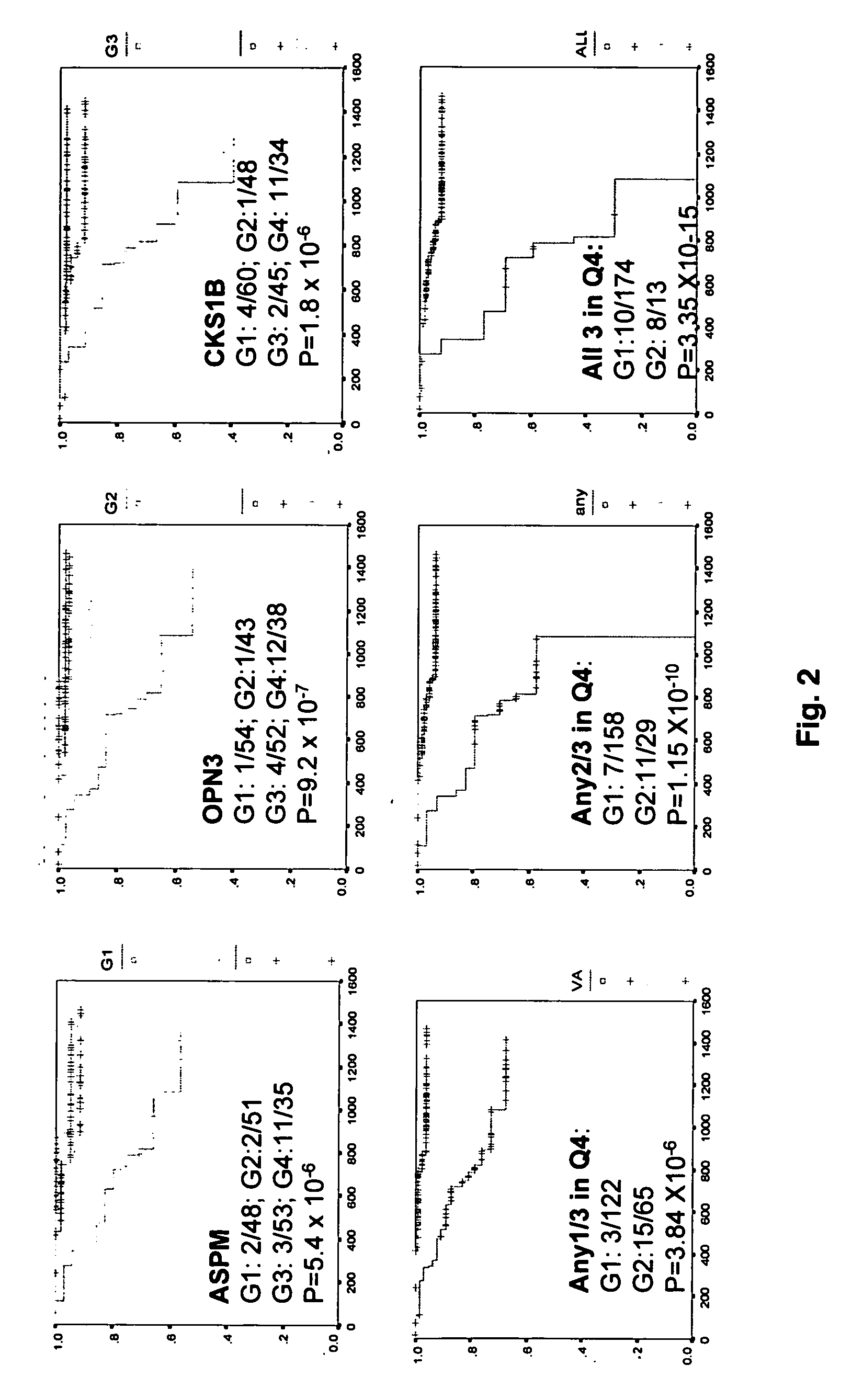Use of gene expression profiling to predict survival in cancer patient
a gene expression and patient technology, applied in the field of cancer research, can solve the problems of unpredictable variability of induction or response duration and long-term survival, drug toxicity, secondary risk,
- Summary
- Abstract
- Description
- Claims
- Application Information
AI Technical Summary
Benefits of technology
Problems solved by technology
Method used
Image
Examples
example 1
Overall Survival Linked to Gain of Chromosome 1 Genes
[0045] This example discloses gene expression profiling data identifying genes whose expression in malignant plasma cells of newly diagnosed myeloma patients is significantly correlated with early death in patients treated with tandem stem cell transplants.
[0046]FIG. 2 shows overall survival analysis on patients with more than 1.5 years follow-up. Patient samples were grouped into quartiles based on levels of gene expression. Q1 is the lowest quartile and Q4 is the highest. There was significant link between poor prognosis and elevated expression of ASPM, OPN3 or CSK1B (FIG. 2, upper panel). The power of survival prediction was increased by grouping two or more of these three genes in the analysis (FIG. 2, lower panel).
[0047] These three genes capable of predicting overall survival can also be used to predict event-free survival (FIG. 3A), and the power of prediction was increased by grouping two or more of the three genes in ...
example 2
Gene Expression Profiling to Identify Candiate Genes as Diagnostic, Prognostic and Potential Targets of High-Risk Phenotype
[0048] As discussed above, global gene expression profile identified genes whose over-expression or lack of expression could be useful for staging and performing a disease follow-up for multiple myeloma and other cancers. This gene profiling was also used to identify genes whose abnormal expression might cause high-risk phenotype of myeloma.
(a) Subjects:
[0049] 668 newly diagnosed patients with symptomatic or progressive multiple myeloma were enrolled in the study, which included 2 cycles of blood stem cell-supported high-dose melphalan (200 mg / m) (Shaughnessy et al., 2003). A subset of 575 patients with available genetic measurements, as described below, constituted the sample for this analysis. Their median follow-up was 30 months. There were 185 progression or death events and 128 deaths. Patient characteristics were as follows: 20% were 65 years or older...
example 3
Results of the Global Gene Expression Profiling:
[0059] On a molecular basis to identify genes that might contributed to high-risk myeloma, gene expression profiles of purified plasma cells were correlated with disease-related and overall survival in 351 newly diagnosed patients treated with 2 cycles of high-dose melphalan.
[0060] Using log rank tests, 70 genes were identified for which fourth or first quartile membership was correlated with a high incidence of disease-related death (Table 2). Although 10% of the genes on the microarray were derived from chromosome 1, 30% of the retained genes were derived from this chromosome (P<0.0001); 9 of 51 quartile 4 genes mapped to chromosome arm 1q and 2 to arm 1p whereas 9 of 19 quartile 1 genes mapped to chromosome arm 1p and none on arm 1q (Table 3). The over-representation of 1q genes among the list of 70 and the observation that amplification of 1q21 was associated with progression and poor prognosis in myeloma (Smadja et al., 2001; S...
PUM
| Property | Measurement | Unit |
|---|---|---|
| fluorescence in | aaaaa | aaaaa |
| fluorescence | aaaaa | aaaaa |
| fluorescence in situ hybridization | aaaaa | aaaaa |
Abstract
Description
Claims
Application Information
 Login to View More
Login to View More - R&D
- Intellectual Property
- Life Sciences
- Materials
- Tech Scout
- Unparalleled Data Quality
- Higher Quality Content
- 60% Fewer Hallucinations
Browse by: Latest US Patents, China's latest patents, Technical Efficacy Thesaurus, Application Domain, Technology Topic, Popular Technical Reports.
© 2025 PatSnap. All rights reserved.Legal|Privacy policy|Modern Slavery Act Transparency Statement|Sitemap|About US| Contact US: help@patsnap.com



